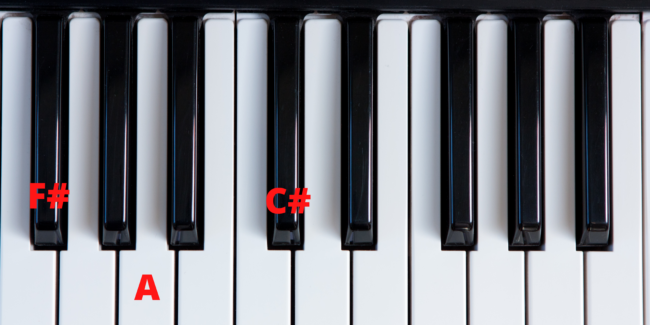Playing the F# Minor Chord (Gb Chord) on Piano

We chord-ially invite you to learn about F# minor! This short article breaks down all you need to know to understand and play this chord.
Sometimes music is like good wine–the more you know about it, the more you can taste when you drink it. Learning music theory helps you taste the flavors of what you hear. And there’s nothing like chords to get your tastebuds tickled. Get a lick of the F# minor chord in this short article.
Chords and inversions.
A chord is when you play two or more notes at the same time. A three-note chord is a triad, the most common.
Chords generally start by being either major or minor. A major chord comprises the first, third and fifth notes of the major scale. It uses two intervals, a major third and then a minor third.
You also build minor chords from the first, third, and fifth notes of a major scale, but the third is flat (lower by a semitone). It has the same two intervals in the opposite order – a minor third and then a major third.
An inversion is when you play these notes in a different arrangement. Triads can appear in three different positions:
Root position: 1, 3, 5.
First inversion: 3, 5, 1.
Second inversion: 5, 1, 3.
Building an F# minor chord.
To make an F# minor chord, we start from the F# major scale.

Then take the first, third and fifth degrees of the scale to make an F# major chord:

Flatten the third degree of the scale (which is the second note of the chord) to make it minor:

F# minor – First inversion.
The first inversion is when you play the chord in the following order:
3, 5, 1.
This is F# minor in first inversion:

F# minor – Second inversion.
The second inversion is when you play the chord like this:
5, 1, 3.
This is F#m in second inversion:

You can learn more about chords here.
F#’s parallel universe – Gb:
Did you know that the note F# is also called Gb? It’s all about the context and related to a rule that you cannot have the same letter appear twice in a scale or chord.
This can create convoluted lettering. As you’ll see below, the third of Gb is Bb. This means that when we flatten the third, we have to keep the letter B, which becomes B double flat (written Bbb).
Here we have all of the above tables with the parallel lettering of Gb. Remember, they still sound the same.
Gb major scale:

Gb major chord:

Gb minor chord

Gb minor first inversion:

Gb minor second inversion:

Play F#/Gb minor in popular songs.
Check out some popular songs that use the F#/Gb minor chord:
- The Final Countdown – Europe
- Shape of My Heart – Sting
- I Hate Everything About You – Three Days Grace
- Beauty and the Beast – Celine Dion
So get on your way!
The sky’s the limit – or at least the end of the piano. Practice playing F#m/Gb minor alongside this article. Make sure you also get the Simply Piano app – it’s an interactive, fun, and easy way to learn chords.









